Jet phenomena in space
In the past couple of decades, a family of new astrophysical phenomena has been recognized—the accretion jet. I’ll show pictures of some here, and compare them and wonder about them.
Many examples of jets are now associated with several rather different physical situations: supermassive black holes, pulsars and neutron stars, and natant stars.
The general picture is that a massive object is accreting matter from a spinning accretion disk. The idea that swirling gas and dust might form cosmic structures such as our solar system is a fairly old one, dating at least from the 1700s. The new surprise, however, is that the arrangement seems to require an extra feature: two intense beams of plasma shooting out perpendicular to the disk—these are the jets.
Jets can occur at vastly different scales: the jet from a pulsar or a natant star may be on the order of a few light-years in length, while the jets from supermassive black holes are among the largest structures recognized in the universe: orders of magnitude larger than their originating galaxies.
It’s very striking to me how similar these jets look, and in some sense, familiar—like blown smoke, billowing in air.
Incidentally, jets are the main suspects as sources of X-ray bursts, very brief, tremendously powerful blasts of X-ray radiation, lasting seconds only, but evidently coming from extremely deep in space. The picture is that somehow they come from such jets, oriented so they point in our direction.
From what I read, and from the answers of several astrophysicists, it seems that understanding of the driving principles of these jets is largely conjectural. Just why and how they are so tightly focused, especially. The best theories involve a twisting of magnetic fields around the jet, but this is in no way predictive. Also, just how so much energy can be transferred to the jets is unknown. It appears to be a complex electrodynamic process. But at the same time… the phenomenon seems to be very common.
It is also likely that they serve to remove large amounts of angular momentum from a system, thereby allowing a disk of material to accrete.
Neutron stars and pulsars
Neutron stars are themselves very small things, and they fade from view within tens of millions of years, so we don’t see a lot of them, and all the ones known are relatively nearby within our galaxy. The ones that remain from a relatively recent supernova are still "hot", and even relatively old ones may flare if they have some source of gas—for example, a closely orbiting star.
Neutron stars are mostly energetic in X-ray frequencies, and so the most detail is visible in X-ray telescopes.
Note that the accretion jet is something distinct from the pulsar’s lighthouse source, which originates from the pulsar’s magnetic poles, sweeping out a cone as the pulsar itself rotates. Presumably, the accretion disk usually aligns with the body’s rotational equator, but the magnetic poles make an angle to the rotational axis. Of course, it’s conceivable that in some cases, all three — the magnetic axis, the body’s rotational axis, and the accretion disk’s axis — are different.
Crab nebula pulsar
This video is a sequence of images made by the Chandra X-ray observatory: it looks like an artist’s rendition of an accretion disk and jet, but these are real observations.
This is a very young hot pulsar, which appears to be the remnant of a supernova recorded in 1054 AD. It is about 6500 light-years distant.
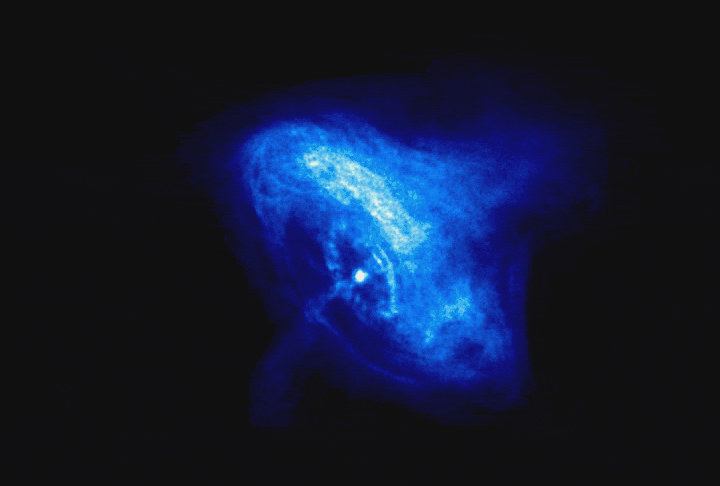
The jet is clearly moving. In the accretion disk, the visible motion is that of shock waves moving through the disk. The jet is about three light-years in length.
neutron star Scorpius X-1
Scorpius X-1 was the first discovered deep-space X-ray source, and after the sun, the strongest X-ray source in our sky. It is relatively nearby (9000 light years distant), and appears to consist of a medium-sized star and a neutron star orbiting one another every 19 hours. The neutron star would strip material off its companion, which would accrete to its surface, periodically producing an accretion disk and jet.

The jet consists of two beams — one points toward us, one away. Here, a clump in the lobe pointing at us, is moving very rapidly — at nearly the speed of light.
From our vantage point, the size of the source and the lobes is very small. These pictures came from numerous radio telescopes; only such equipment could resolve these small details. (Optical and X-ray telescopes show only a star, V818 Scorpii.)
pulsar in the Lighthouse Nebula
also referred to as IGR J11014-6103, is also in our galaxy, about 23000 light-years distant. It has the longest jet, 37 light-years, from any pulsar yet known. The speed of the jet appears to be about 80% the speed of light. The pulsar itself is also moving very fast relative to the other stars in the galaxy, and very fast from a supernova remnant that appears to be its origin.
This composite image shows the region around the pulsar in X-ray (from the Chandra observatory), infrared light from the 2MASS observatory, and visible light from the Digitized Sky Survey.
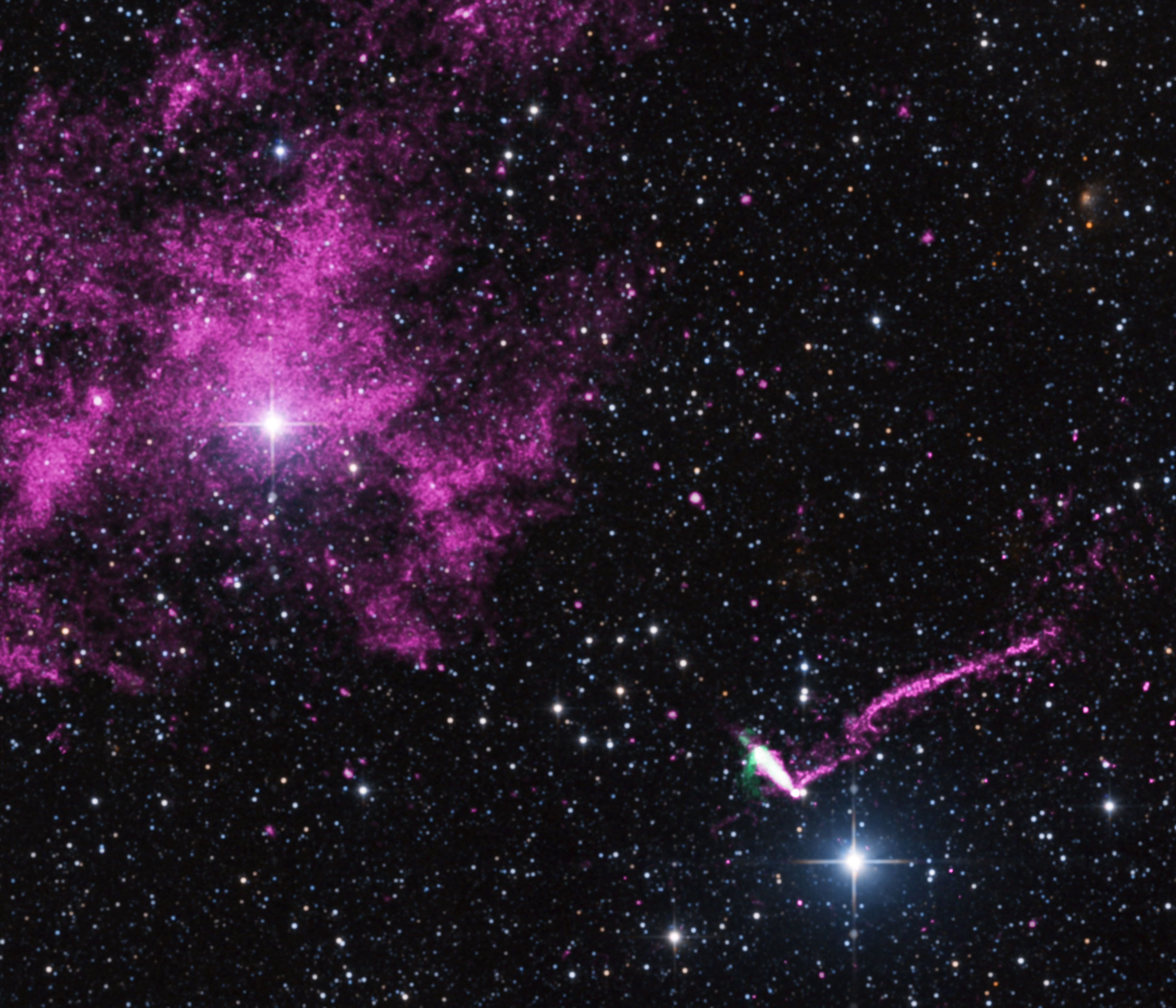
The purple-colored cloud in the top left is X-ray emission from a supernova remnant. The white smudge in the lower right is radio and X-ray emission from the “pulsar wind”. The snake-shaped artifact is X-ray emission from the jet.
It isn’t known why this jet has a kink in it — there are several theories.
As to why the pulsar is moving so rapidly with respect to its apparent origin and the rest of the galaxy, the main theory is that it had been part of a binary object, and a supernova ejected most of the mass of one object of the pair, giving a big kick to the pulsar.
Jets from natant stars
Jets come out of gas clouds where, presumably, young stars are accreting. All the known examples are relatively nearby, within a few thousand light-years, within our galaxy. They aren’t particularly powerful, and in most cases, the very dust from which the accretion disk formed, obscures the star, so they are visible only with the best modern telescopes.
Such jets glow at frequencies visible with optical or infrared telescopes, and are on the order of tens of light-years in length. Typically, the cloud obscures the star itself (which may yet be visible in the infrared spectrum, to which the dust is relatively transparent).
Some of these stars are designated with "HH", which stands for "Herbig-Haro", astronomers who listed nebulosities associated with young stars.
HH 24
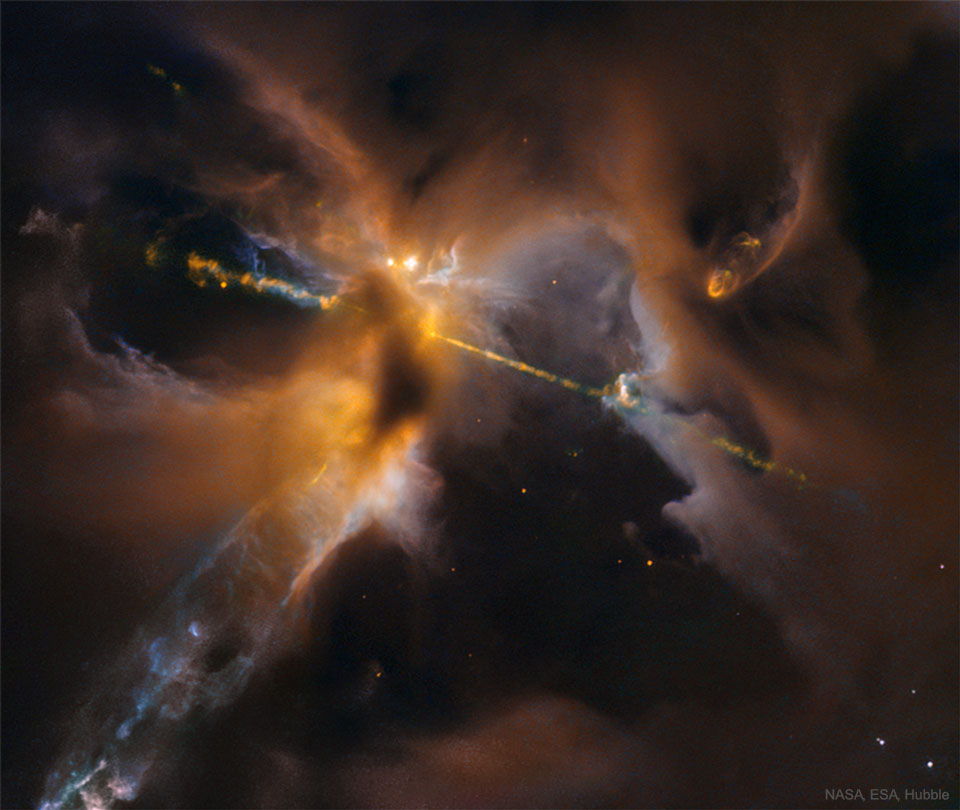
About 1,300 light-years away, the image is about a half light-year across.
More info.
HH 30
A very young star with a visible accretion disk and jet. About 450 light-years away. This is one of the few cases where the accretion disk itself is visible.
This video is a composite of Hubble Space Telescope images over a 5-year period. The rotation of a disk is apparent. Current estimates of the jet’s velocity have it at around half a million kilometers per hour — comparable to the speed of our sun’s solar wind.
Besides the jets, there is a dark band across the middle, which seems to be opaque material from the disk. Only the upper and lower portions of the disk are visible, and the disk hides star itself completely. (This is typical of the few examples we have of visible formation of stars.)
This star is in what is called the T Tauri phase of its development. It’s rare to find such a star, as the phase is short-lived relative to the lifetimes of stars, and because it must be very nearby for current instruments to resolve such detail.
HH 47
Jet from a star about 1400 light-years away. The time-lapse video shows the material in the jet moving against background stars. Here, again, the dust cloud hides the star itself.
More information
HH 111
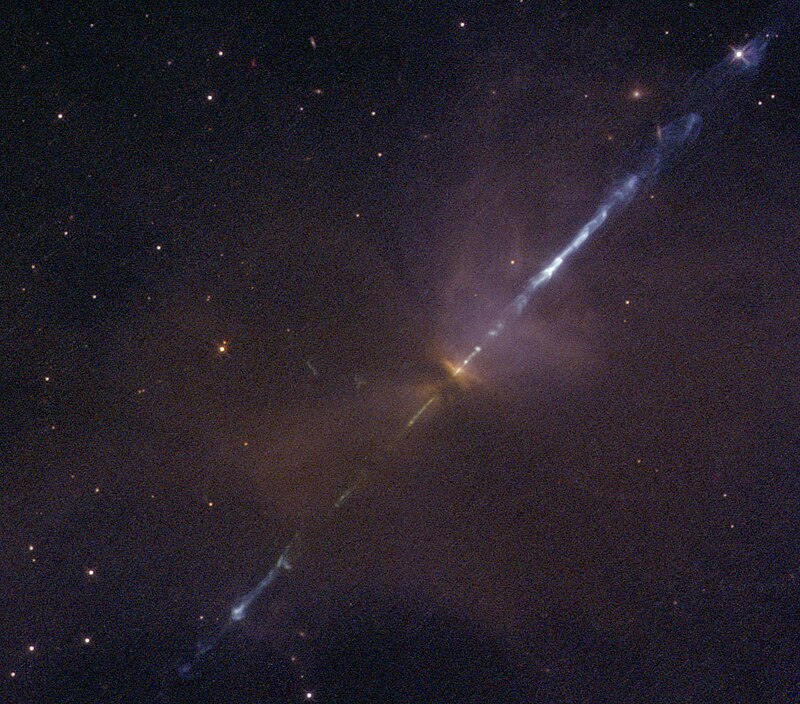
About 1300 light-years distant.
HH 901 and HH 902
Two beautiful examples of jets clearly visible emerging from dense clouds in the Carina Nebula. They’re at the tips of the two main pillars of gas.

It’s very interesting that both appear just at the apparent surface of their denser gas clouds. Furthermore, in both cases the jet appears almost tangent to the surface of the cloud. Coincidence? Maybe.
A shock front associated with the jet in the interstellar gas is also visible there.
Galactic Jets
The jets observed coming from the center of some galaxies are vastly larger and more powerful than those from stars and pulsars. Measurements of the speed of jet material have it sometimes at half the speed of light. These are some of the largest structures known in the universe, on the order of tens of millions of light-years across (similar to the distance of our galaxy to the Andromeda galaxy). The only plausible explanation of these jets to date is that they originate from accretion disks about supermassive black holes (of a hundred million or even a billion times our sun’s mass).
These were the first cosmic jets discovered, starting with radio observations in the late 1930s, at which time their sources appeared as some of the brightest radio sources in the sky. It wasn’t until the 1970s that they were recognized as being huge structures, and the notion that they arise from black hole accretion disks was first proposed.
Some dozens of these have now been studied. The ones below are just a few I liked. (Those with designations starting with "3C" are from the "3rd Cambridge Radio Catalog" of strong astronomical radio sources.)
The outer lobes of the jets are not bright in wavelengths we can see. The gas excited by the jets glows brightly at radio wavelengths, and the immediate axis of the jet also shines brightly in X-ray wavelengths.
Our own galaxy has a big black hole in its center, but not as big as the one in these galaxies. And it hasn’t had a source of gas for a long time. It probably gobbles a star occasionally. But such activity would be much tamer than what is going on in the galaxies below. I would surmise that nothing lives in such a galaxy.
galaxy Hercules A
This is a very big galaxy, very far away, with something very major going on in its core. Current estimates have its mass at a thousand times more than our own, and that of its central black hole, a thousand times more than our galaxy’s.
Although as a radio source is the brightest in the Hercules constellation, it took astronomers some time to identify it with the very dim optical image of the faraway galaxy.
It is some 2 billion light-years distant, and the jets are a million or so light-years long.
Here is a composite of the radio image (purple) from the Very Large Array radio telescope, with an optical image from the Hubble Space Telescope.
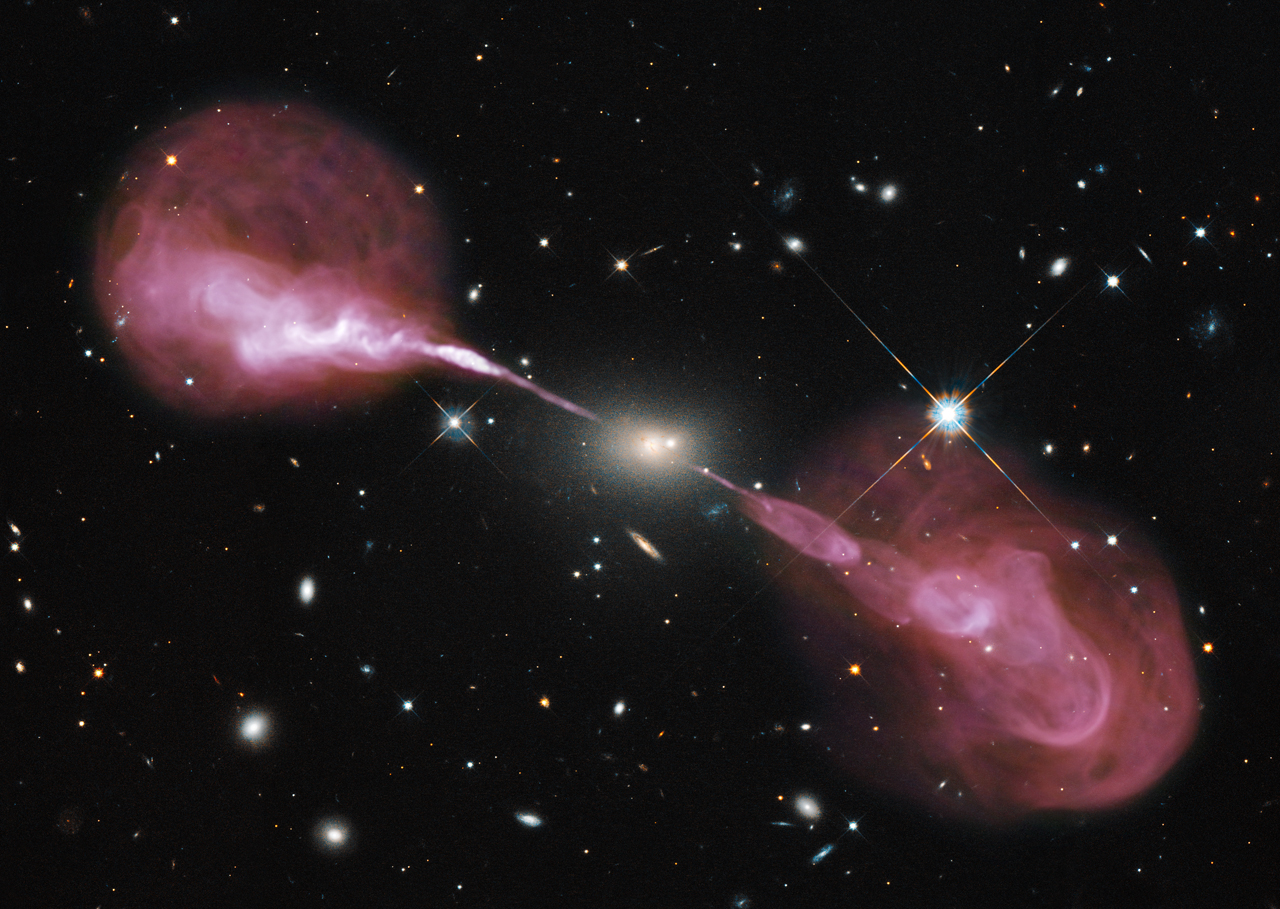
galaxy Centaurus A
This galaxy is relatively near, about 14 million light-years away (so it’s a member of our "local group" of galaxies).
In the composite image, X-ray is colored blue, and radio is colored orange.
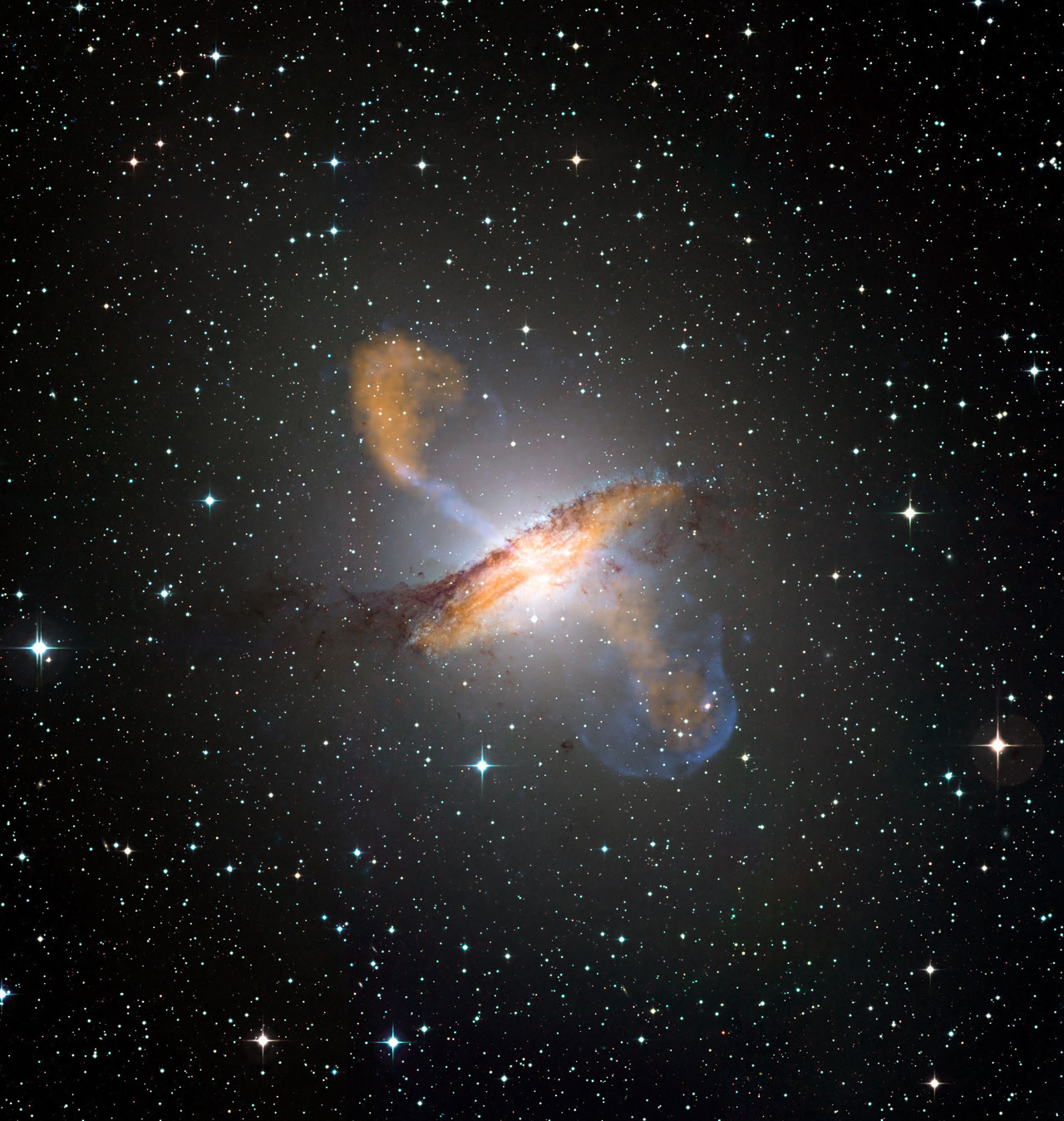
In absolute size, the jets are millions of light-years in width. If the radio glow of these jets were visible to our eyes, they would cover an area of our sky a dozen times as wide as the moon.
The object has the dark dust lanes typical of spiral galaxies, but pictures in some wavelengths show plainly that these are superposed on a larger elliptical galaxy. It seems to be a case of a collision of a larger elliptical galaxy containing a large black hole, with a smaller spiral galaxy.
galaxy Cygnus A
This one is a little farther, about 600 million light years distant.
The image is in the 500 GHz radio spectrum, and shows again intensely focused beams coming from a very small source finally interacting with the intergalactic medium.
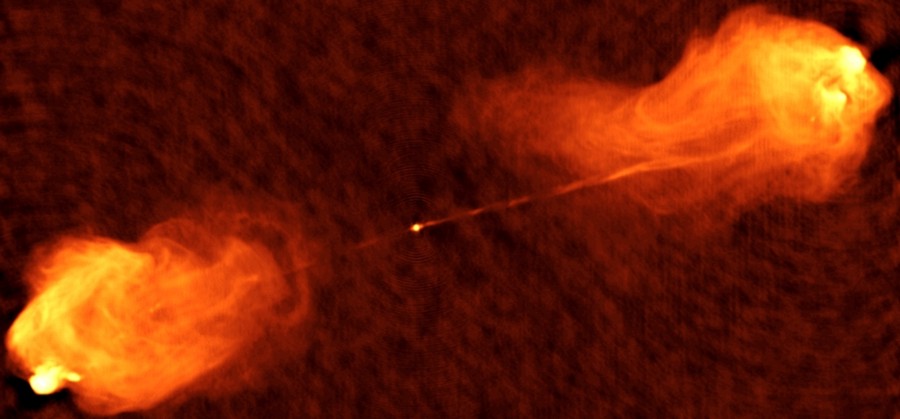
A quite different perspective of the same jets by the Chandra X-ray observatory shows three bright spots, the source, and two equally spaced spots at the end of the jets:
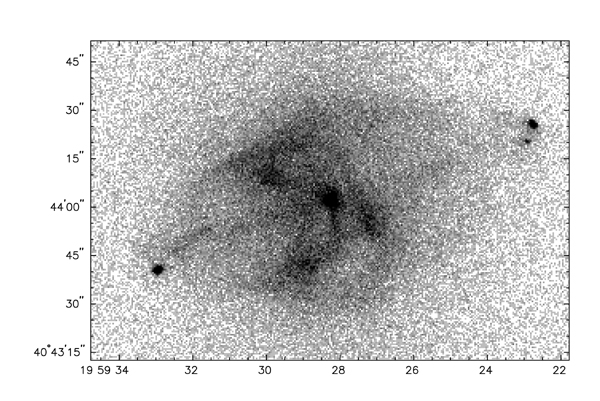
Here is what the Hubble Space Telescope makes of the source galaxy, in visible light:
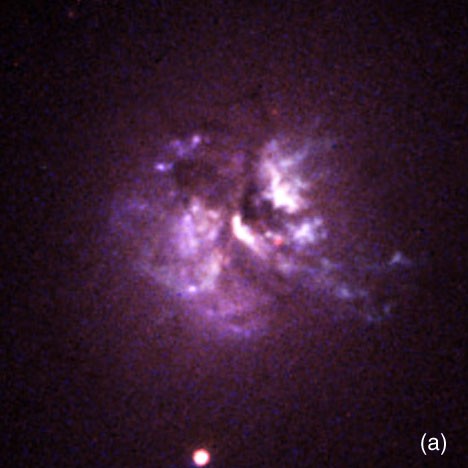
This is the region just around the central spot in the X-ray and radio images. The jets aren’t visible here, but the source galaxy is clearly a very messy place. Maybe galaxies are colliding here too.
radio galaxy 3C353
This is radio galaxy 3C353: a composite of X-rays (from the Chandrasekhar space telescope in purple) and radio (using the VLA radio telescope in orange).
It has only received attention in recent years; even its cluster of galaxies is unnamed. And I don’t find any other images of it, or information of how distant it might be.

Further info, and the radio image alone, at
NRAO: 3C353 = B1717-009
The whole image spans about 4 million light-years. The X-rays appear to be very tightly focused, with "knots" appearing along their lines. Curiously, although they are very slender, the two jets appear to be misaligned to one another by about 5°.
radio galaxy 3C31 (NGC 383)
Jets in galaxy NGC 383 (radio galaxy 3C31), from Hubble Space Telescope and the NRAO VLA radio telescope.
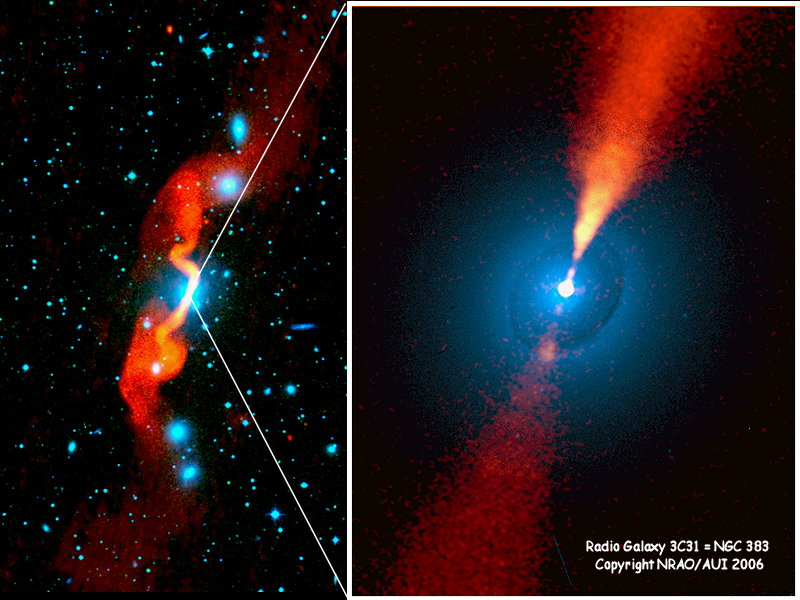
Image courtesy of NRAO/AUI
More information
This galaxy is one of a string of galaxies, apparently associated with one another, about 200 million light-years distant.
galaxy Virgo A (Messier 87)
This elliptical galaxy is the dominant galaxy of our galactic neighborhood, about 50 million light-years away.
This is a Hubble Space Telescope image, showing a visible galactic jet, whose length is some 5000 light-years.

The galaxy is a doozy, by some estimates 200 times the mass of our own galaxy.
It doesn’t look like much, because it’s almost perfectly ellipsoidal, and because it has evaporated almost all the dust it may once have contained.
To my eye, the jet in this example looks suspiciously like a thin light beam illuminating smoke.
radio galaxy Porphyrion
This galaxy has the longest jets known, at the time of this writing — some 23 million light-years from one lobe to its opposite. That is more than 100 times the diameter of the Milky Way. The galaxy itself is about 7.5 billion light-years distant, and about 10 times larger than the Milky Way.

The image is a product of the International LOFAR (LOw Frequencey ARray) radio telescope (ILT). That means, the image is not of visible light, but of radio-frequency radiation coming from the galaxy and its jets.
The discovery of the galaxy was part of a survey for such structures, and it is by no means alone. The survey found more than 10,000 of them.
The original paper: Black hole jets on the scale of the Cosmic Web.